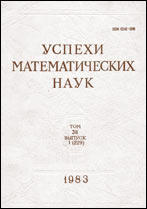|
This article is cited in 102 scientific papers (total in 103 papers)
Normal forms of functions in neighbourhoods of degenerate critical points
V. I. Arnol'd
Abstract:
An analysis of the normal forms to which functions can be reduced in neighbourhoods of degenerate critical points shows that many of them are quasihomogeneous or semiquasihomogeneous. A semiquasihomogeneous function is a sum of a quasihomogeneous (or weighted homogeneous) polynomial with an isolated critical point and summands of a higher degree of quasihomogeneity. The normal form to which a semiquasihomogeneous function can be reduced is described in terms of the local ring of the gradient mapping given by the quasihomogeneous part of the function. The number of parameters in this normal form is called the inner modality of the quasihomogeneous part.
A classification is given of all quasihomogeneous critical points of inner modality 1: up to stable equivalence they are exhausted by three one-parameter families of parabolic singularities and 14 exceptional polynomials, 8 of which are functions of two variables, and 6 functions of three variables.
Received: 28.09.1973
Citation:
V. I. Arnol'd, “Normal forms of functions in neighbourhoods of degenerate critical points”, Russian Math. Surveys, 29:2 (1974), 10–50
Linking options:
https://www.mathnet.ru/eng/rm4352https://doi.org/10.1070/RM1974v029n02ABEH003846 https://www.mathnet.ru/eng/rm/v29/i2/p11
|


| Statistics & downloads: |
| Abstract page: | 2053 | | Russian version PDF: | 838 | | English version PDF: | 129 | | References: | 149 | | First page: | 6 |
|




 Contact us:
Contact us: Terms of Use
Terms of Use
 Registration to the website
Registration to the website Logotypes
Logotypes








 Citation in format
Citation in format 
